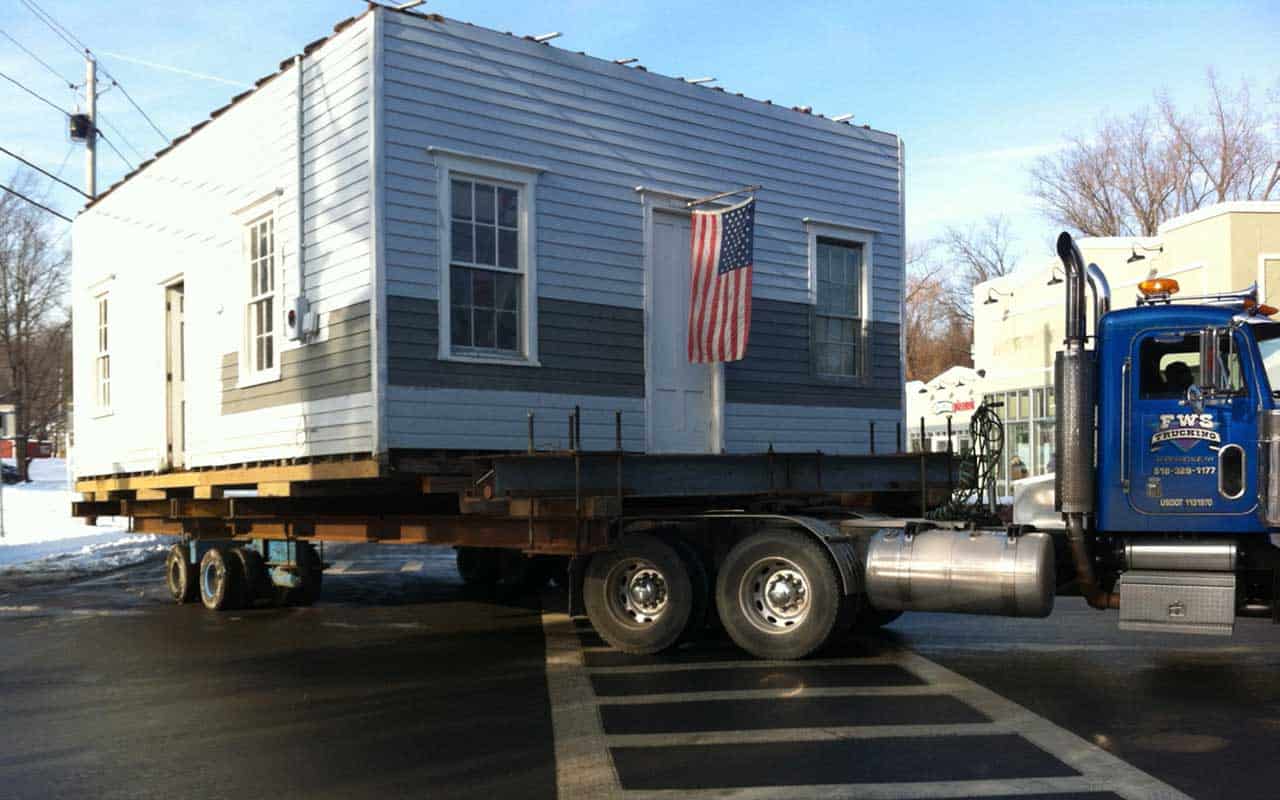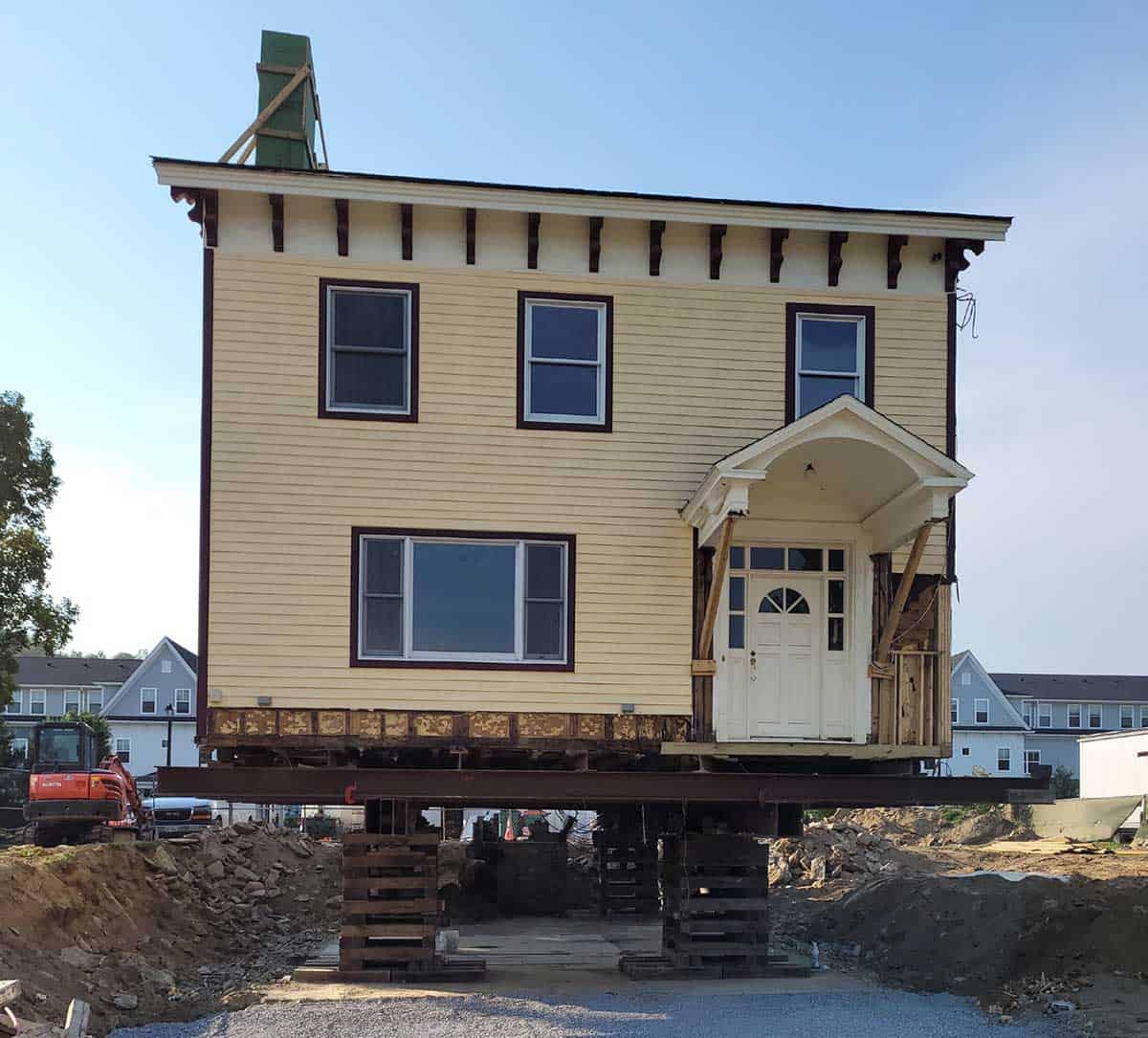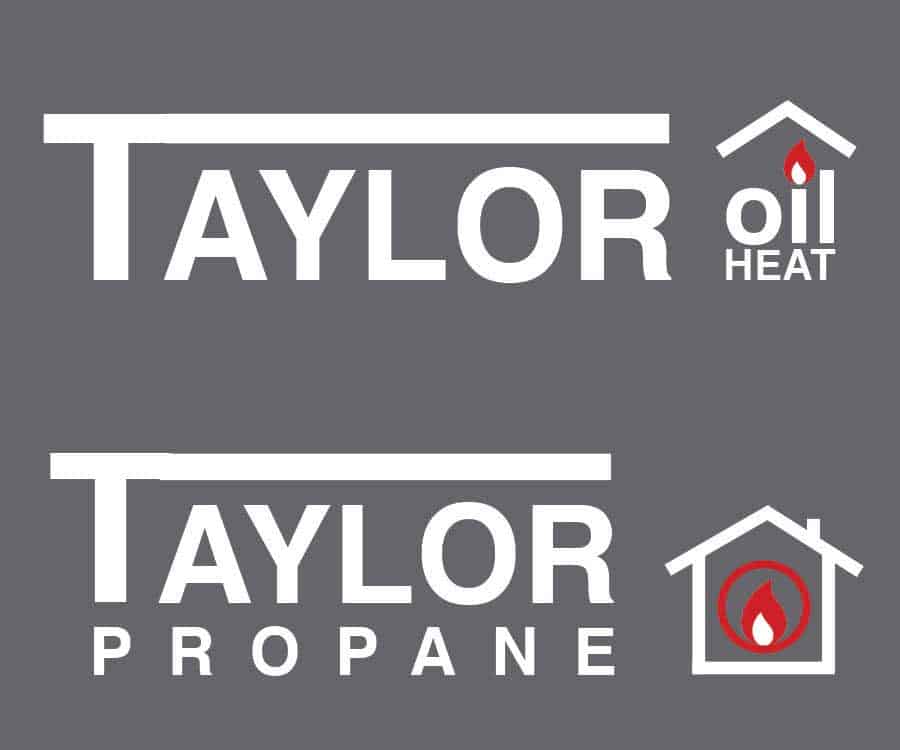Real Estate

Building In The Wrong Place
Real estate buyers frequently tell me that the house that fits their every need is “just too close to the road, too noisy, not private.” In Main Street’s May 2017 issue, I asked other realtors about the “road” discount on a home’s price. Experienced brokers estimated a discount between 5% to 30% with double the time on the market. Road proximity can be particularly true of antique houses which were purposely built close to the road for easy access. This made me wonder why more homeowners with sufficient land did not relocate their homes. How hard could it be? How much would it cost? And what about climate change? With new flood zones and higher FEMA insurance premiums, should more houses be elevated?
Relocating buildings is not new
Even before motorized vehicles and steam engines, people have relocated buildings because they were just in the wrong place. (See photo above of the “Beehive” in Millerton, NY, moved a hundred feet with horses to make way for the creation of Highland Drive). Moving buildings may be the world’s largest and oldest recycling industry. Barns, greenhouses, light houses, summer cottages, 11-story buildings, gas stations, churches, historic buildings and houses have all been moved horizontally to satisfy a need for a better view, to lessen noise from a road or protect historic structures threatened with demolition. Waterfront homes can be elevated to combat the threat of rising water levels.
How do you move a structure?
Moving any major structure takes a team of experts: a general contractor, structural movers, electricians, plumbers, and a concrete foundation company. Joe Nicholas, the sixth generation of Nicholas Bros Building Movers in Hopewell Junction, NY, explained the basics of moving a building today.
Steel I-beams are placed under the sills of the house, unified hydraulic jacks lift the structure, and then pneumatic dollies are placed under the building to move it to its new location on a new foundation facing the right direction. The Henry Frank house Nicholas moved across Route 44 in Poughkeepsie in October 2021 as part of the Eastdale Village development project and cost $60,000 for the move alone (see photo next page). The trip across the highway took only 30 minutes but the prep, permitting, and new site preparation effort were the expensive part. You can view the house crossing Route 44 on YouTube – lots of people turned out to watch.
The project to move the Irondale Schoolhouse to nearby Main Street in Millerton, NY, took eight years and $120,000 to complete but included the acquisition of the historic structure, land permitting from the county, and renovation. Ralph Fedele, the community visionary behind the project explained, “First the building must be carefully measured, and the route checked. The vertical profile once loaded on a flatbed must be lower than the overhead wires. Tree limbs and anything else that might restrict movement must be carefully checked. The move itself down Route 22 and around the corner to Route 44 cost only $29,000.” (See photo left of schoolhouse rounding the corner of Routes 22 and 44, the building is now located next to the Harlem Valley Rail Trail and Brick Block Auto Parts).
How much would it cost to move my house?
There is no price per square foot estimate when it comes to moving a building. Every move is unique. The total cost will be determined by the size, shape, type of structure, and type and height of the foundation. Crawl spaces under three feet and houses built on slabs are more costly to move than homes sitting on full basements. Building accessories like porches, fireplaces, and decks can be moved with the building, but will add to the cost.
Sufficient room is required around the house to use standard mechanized equipment. Before the move all utilities must be shut off, all pipes, plumbing and duck work removed from underneath the floor joists, not to mention shrubbery that might be in the way. And then there is the move route. How far will the house travel? If the house is moving to the back of a property, the move cost is much less than moving the house across the road or down a highway. Clearing the route is a very large price factor. The cost of lifting utility lines, traffic signals, and signs, and permitting keeps most moves in the Northeast under one to two miles.
So really how much would it cost to move a simple structure 100’ back from a road on level ground? Nicholas estimated that moving a small structure like a garage might only cost $9,000 to move on the same property while a house might cost $40,000 to $45,000 without much difference in price between a distance of 100 feet and 200 feet. On top of this is there is the cost of a new foundation, disconnecting and reconnecting mechanics, and a longer driveway.
Moving up and up
Structural movers in our region observed that they are getting more and more work elevating structures affected by flooding; 100-year storms seem to be happening every ten years. Hurricane Sandy damaged or destroyed over 650,000 houses and affected over six million Americans. An estimated three million older and historic buildings in US are in flood zones and vulnerable to storms.
Elevating a home in advance of storm surges or flooding will also lower insurance rates which are expected to increase dramatically for properties at risk. Areas of Dutchess and Columbia counties in NY have a moderate flood risk over the next 30 years while Litchfield and Berkshire counties in CT and MA respectively are estimated to have a major risk. The Long Island coast where Nicholas elevated Katherine Hepburn’s former house in Old Saybrook, is especially vulnerable. Raising a house is less expensive than moving it, but involves the same type of specialized equipment and expertise. Houses are also elevated to repair or replace existing foundations.
The “Flying Church,” the oldest church in Great Barrington, MA, was raised 6’9” to add square footage to the building to allow retail development. The remnants of the town’s Pumpkin Hollow Road bridge were added to the north side after the building was elevated to provide disabled access to the building. The repurposed church will house residential, office, retail and restaurant spaces.
Raising roofs is another service offered by structural movers. Some property owners seek to add space on the same footprint by lifting the existing roof and securing it to support columns to add another story. This can double or triple the cubic space economically and is usually done for commercial and warehouse facilities.
Moving a house in pieces
Today’s modular houses are designed to be able to move on flatbed trucks as wide loads avoiding the problem of overhead wires and other obstructions. Westchester Modular builds houses in their facility in Wingdale and transports them in pieces to the house site where they are lifted by crane, placed on new foundations and joined together (see photo below left). This type of house could be disassembled and trucked to a new site if necessary.
The decision to move a house up or over is a bold and imaginative one and anyone contemplating it should carefully research all the costs involved. Most likely it will make economic sense for valuable or historic structures or if the foundation needs to be replaced anyway. And remember there’s the additional cost of living somewhere else for a few months while the building is prepared for a move and you’ll have to clean out your basement.
Christine Bates, a real estate agent in New York and Connecticut with William Pitt Sotheby’s, has written about all things real estate since the magazine’s first issue.





